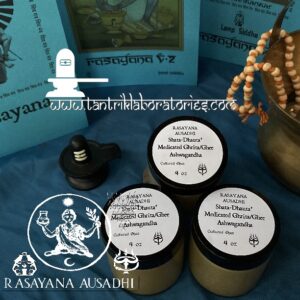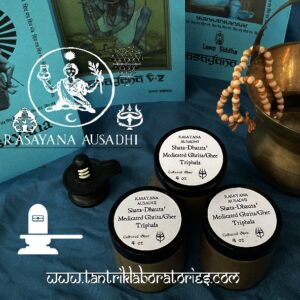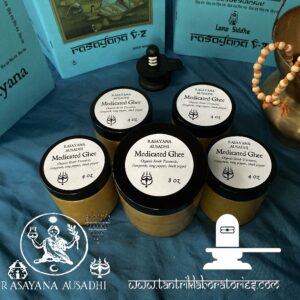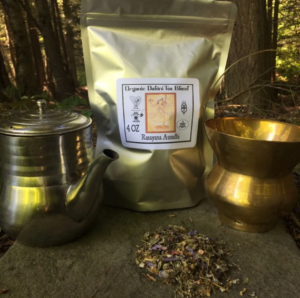Ashawagandha is the cherished herbal adaptogen for stress, adrenal balance and libido and so much more. We infuse organic, cultured ghee using the traditional Ayurvedic methods of slow, low heat, purifications in water and washing, that culminate in the purest, finest and most bioavailable product.
Our organic herbs are infused into Grassfed Organic Cultured Ghee in our artisan line of small-batch traditional made in traditional copper vessels. We started this line with the Master Siddha herbalists of Ayurveda to produce the apex of medicated ghee or ghrita for maximum bioavailability. Indian or Desi ghee is the traditional Indian ghee made from cow’s milk that is first collected and saved for a few days to “culture”. The cultured milk is then churned to produce butter. Churning separates the emulsified fats in the milk from the liquid or aqueous portion of the milk. This is the most medicated ghee which is then washed and cleansed.
These are the best, efficient and bioavailable means of delivering herbal formula deep into the body, and are especially useful in gut health. Thus, this product is truly a yogavahi—a catalytic agent that carries the medicinal properties of herbs into the seven dhatus or tissues of the body. Ghee pacifies pitta and vata and is acceptable, in moderation, for kapha. Charaka Samhita. This means that they only produce their ghee from cultured butter, also known as Makhan. Makhan is made by transforming cream from cows (which are revered and considered sacred in India) into yogurt and then by churning the yogurt into butter. From there, cooking small batches of the cultured butter over an open flame to clarify the butter into ghee. This process of clarifying butter into ghee removes the milk fat solids, casein and lactose from the butter leaving only the healthy, ojas building fat which is known as ghee.
This process is called ‘Murcchana’ samskara (fat processing) is assumed as one of the crucial step in ghrita preparation entailing the use of ‘Murcchita’ ghee i.e. ghee prepared with incorporation of Murcchana herbs y ghritapaka (ghrita preparation), ghee should undergo ‘Murcchana’ samskara to enhance the medicinal potency of a ghrita and to get rid of bad odour and rancidity. ‘Shata-Dhauta’ is a process involves washing of purified ghee one hundred times with water which increases stability of ghrita and makes it elegant and suitable product for topical application cow ghee increases the potency of certain herbal ingredients by carrying the lipid soluble active components to the interior of the cell Ayurvedic texts. Briefly, the stated quantity of ghee (Sneha Dravya) was poured in a large stainless steel vessel and allowed to melt under moderate flame. Further, the plant extracts (Kalka) in equal proportion, water (Drava Dravya) and molten ghee (Sneha Dravya) were combined in specified ratio of 1:16:4 respectively in same vessel and boiling was initiated till the complete evaporation of moisture and appearance of characteristic features of ghrita. The whole process of ‘Ghrita Paka Kalpana’ was carried out on mild to moderate flame and continued until ‘Sneha Siddhi Lakshana’ was obtained. The ‘Sneha Siddhi Lakshana’ is of burning of paste (Varti) without crackling sounds and disappearance of froth (Phena) in ghrita To increase therapeutic quality, purity, efficacy and stability/shelf life, the prepared PHBG-I was optimized by processing with ‘Murcchana’ and ‘Shata-Dhauta’ samskara as per the ancient Ayurvedic procedures.
This batch is infused with Organic Ashwagandha (Withania somnifera) Sometimes called “Indian Ginseng” but known commonly as winter cherry, Ashwagandha has a truly ancient history and folk use that is verified by many modern studies and popular usage in the modern era. It is considered a nervine tonic, aphrodisiac, deobstruent (removing obstructions in any system of the human body), a sedative and adaptogen. Its name reflects the quality of imparting the raw sexual energy of a horse to the human being and the smell of a horse and the fresh root are similar (ashwa-horse, gandha-smell). The ancient and modern clinical texts agree it is beneficial for all ages and sexes, for rejuvenation therapy, giving energy, relieving inflammation, aches and pains, generative system health, nervous conditions, and disease of vata. It has many uses for gynecological issues and for many mental conditions. It is considered a narcotic and calming as its Latin name somnifera confirms. It is used in many formulae for the various above conditions and there are specific recipes and protocols that use this herb as a foundation ingredient and aspect from treating sexual dysfunction, sterility, to sleeplessness. It can act as an anabolic agent as it contains steroidal substances and has shown to promote growth by enhancing tissue components with and without the release of growth hormones. Likewise, ashwagandha exhibits immunomodulator activity, anti-cancer properties used in therapy, ‘anti-stress,’ and is shown to increase energy endurance. It is a classic ‘geriatric tonic’ with studies showing it increase hemoglobin count and hair melanin and decrease serum cholesterol and erythrocyte sedimentation (a general test of inflammation in the body), slowing Alzheimer and in combination with herbs such as Tribulus, ginseng and milk was shown to increase psychomotor performance, increase strength, viability process and endurance. It has shown significant use as anti-ulcerative and anti-inflammatory agent and used in skin disease, female hair loss after childbirth, liver disease, and a potent antioxidant. See Ashwagandha full entry in Rasayana V.1
To take ghee as a supplement, dissolve 1/2-1 teaspoon ghee in 1/2 cup warm water and drink it on an empty stomach. Cultured ghee is more refined and subtle than regular ghee, and thus able to penetrate deeply into your cells to deliver nourishment.




 Adding...
Adding...